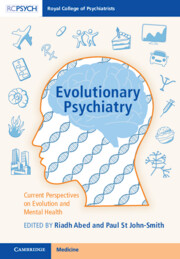Book contents
- Evolutionary Psychiatry
- Reviews
- Evolutionary Psychiatry
- Copyright page
- Contents
- Contributors
- Foreword
- Preface
- Chapter 1 Introduction to Evolutionary Psychiatry
- Chapter 2 The Biopsychosocial Model Advanced by Evolutionary Theory
- Chapter 3 Hominin Evolution I
- Chapter 4 Hominin Evolution II
- Chapter 5 Hunter-Gatherers, Mismatch and Mental Disorder
- Chapter 6 Why Do Mental Disorders Persist?
- Chapter 7 Anxiety Disorders in Evolutionary Perspective
- Chapter 8 Evolutionary Perspectives on Depression
- Chapter 9 On the Randomness of Suicide
- Chapter 10 Evolutionary Perspectives on Schizophrenia Spectrum Disorders
- Chapter 11 Evolutionary Perspectives on Eating Disorders
- Chapter 12 Substance Abuse and Evolution
- Chapter 13 The Social Function of Alcohol from an Evolutionary Perspective
- Chapter 14 Evolutionary Perspectives on Childhood Trauma
- Chapter 15 Evolutionary Perspectives on Neurodevelopmental Disorders
- Chapter 16 Maternal Negativity and Child Maltreatment
- Chapter 17 Alzheimer’s Disease as a Disease of Evolutionary Mismatch, with a Focus on Reproductive Life History
- Chapter 18 Psychopharmacology and Evolution
- Chapter 19 What the Evolutionary and Cognitive Sciences Offer the Sciences of Crime and Justice
- Chapter 20 Evolutionary Thinking and Clinical Care of Psychiatric Patients
- Index
- References
Chapter 9 - On the Randomness of Suicide
An Evolutionary, Clinical Call to Transcend Suicide Risk Assessment
Published online by Cambridge University Press: 08 September 2022
- Evolutionary Psychiatry
- Reviews
- Evolutionary Psychiatry
- Copyright page
- Contents
- Contributors
- Foreword
- Preface
- Chapter 1 Introduction to Evolutionary Psychiatry
- Chapter 2 The Biopsychosocial Model Advanced by Evolutionary Theory
- Chapter 3 Hominin Evolution I
- Chapter 4 Hominin Evolution II
- Chapter 5 Hunter-Gatherers, Mismatch and Mental Disorder
- Chapter 6 Why Do Mental Disorders Persist?
- Chapter 7 Anxiety Disorders in Evolutionary Perspective
- Chapter 8 Evolutionary Perspectives on Depression
- Chapter 9 On the Randomness of Suicide
- Chapter 10 Evolutionary Perspectives on Schizophrenia Spectrum Disorders
- Chapter 11 Evolutionary Perspectives on Eating Disorders
- Chapter 12 Substance Abuse and Evolution
- Chapter 13 The Social Function of Alcohol from an Evolutionary Perspective
- Chapter 14 Evolutionary Perspectives on Childhood Trauma
- Chapter 15 Evolutionary Perspectives on Neurodevelopmental Disorders
- Chapter 16 Maternal Negativity and Child Maltreatment
- Chapter 17 Alzheimer’s Disease as a Disease of Evolutionary Mismatch, with a Focus on Reproductive Life History
- Chapter 18 Psychopharmacology and Evolution
- Chapter 19 What the Evolutionary and Cognitive Sciences Offer the Sciences of Crime and Justice
- Chapter 20 Evolutionary Thinking and Clinical Care of Psychiatric Patients
- Index
- References
Summary
Converging theoretical and empirical evidence points to suicide being a fundamentally aleatory event – that risk of suicide is opaque to useful assessment at the level of the individual. This chapter presents an integrated evolutionary and clinical argument that the time has come to transcend efforts to categorise peoples’ risk of taking their own lives. A brighter future awaits mental healthcare if the behaviour’s essential non-predictability is understood and accepted. The pain-brain evolutionary theory of suicide predicts inter alia that all intellectually competent humans carry the potential for suicide, and that suicides will occur largely at random. The randomness arises because, over an evolutionary timescale, selection of adaptive defences will have sought out and exploited all operative correlates of suicide and will thus have exhausted those correlates’ predictive power. Completed suicides are therefore statistical residuals – events intrinsically devoid of informational cues by which the organism could have avoided self-destruction. Empirical evidence supports this theoretical expectation. Suicide resists useful prediction at the level of the individual. Regardless of the means by which the assessment is made, people rated ‘high risk’ seldom take their own lives, even over extended periods. Consequently, if a prevention treatment is sufficiently safe and effective to be worth allotting to the ‘high-risk’ subset of a cohort of patients, it will be just as worthwhile for the rest. Prevention measures will offer the greatest prospects for success where the aleatory nature of suicide is accepted, acknowledging that ‘fault’ for rare, near-random, self-induced death resides not within the individual but as a universal human potentiality. A realistic, evolution-informed, clinical approach is proposed that focuses on risk communication in place of risk assessment. All normally sapient humans carry a vanishingly small daily risk of taking their own lives but are very well adapted to avoiding that outcome. Almost all of us nearly always find other solutions to the stresses of living.
- Type
- Chapter
- Information
- Evolutionary PsychiatryCurrent Perspectives on Evolution and Mental Health, pp. 134 - 152Publisher: Cambridge University PressPrint publication year: 2022
References
- 3
- Cited by



